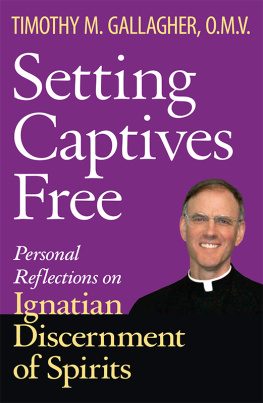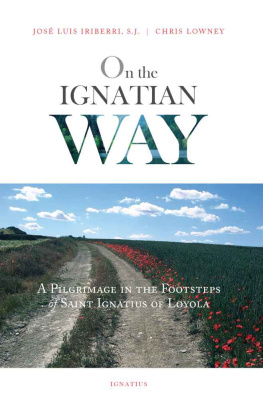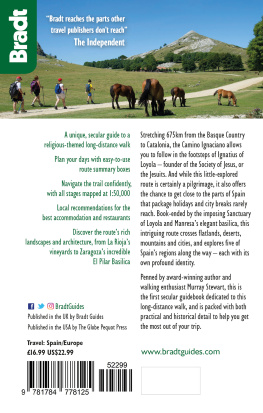

3441 N. Ashland Avenue
Chicago, Illinois 60657
(800) 621-1008
www.loyolapress.com
2020 Brendan McManus, SJ
All rights reserved.
This book has been approved by the Irish Jesuit censor, process completed through the Irish Jesuit Curia office, Milltown Park, Dublin, 2017.
Scripture quotations are from New Revised Standard Version Bible: Catholic Edition, copyright 1989, 1993 National Council of the Churches of Christ in the United States of America. Used by permission. All rights reserved worldwide.
Disclaimer: I have tried to recreate events, locales, and conversations from my memories of them. In order to maintain their anonymity, in some instances, I have changed the names of individuals and places, and I may have changed some identifying characteristics and details such as physical properties, occupations, and places of residence.
Cover art credits: Clockwise from top left: Brendan McManus, SJ. Jose A. Bernat Bacete/Moment/Getty Images. RapidEye/E+/Getty Images. Brendan McManus, SJ. Thomas Rochford, SJ and JJ Mueller, SJ/Jesuits of the Missouri Province. Background: Brendan McManus, SJ. Background Textures: Paper: duncan1890/iStock/Getty Images. Leather: makkayak/E+/Getty Images.
Photo insert art credits: All photos by Brendan McManus, SJ, except the MAGIS 2016 concert photo by Jakub Nicieja. Used by permission.
The Ignatian Camino Route courtesy of Jos Luis Irriberri, SJ
eBook ISBN: 978-0-8294-4957-0
Based on the print edition: 978-0-8294-4956-3
Library of Congress Control Number: 2020932015
20 21 22 23 24 EPUB 5 4 3 2 1
AMDG

Like many organizations and movements, the Society of Jesus, whose members are known as the Jesuits, is based on the experience of its founder, St. Ignatius of Loyola. People have varying stereotypical perceptions of Ignatius as the counterreformer, the grim ascetic, the great mystic, or the military ruler of a Catholic order. However, it is in reading the account of his life that he dictated and the Constitutions of the Jesuits, and in piecing together Ignatiuss correspondence that we come to understand Ignatius principally as a pilgrim. In 1522, he cast off the trappings of his old life and limped around Europe as a poor beggar trying to discover what God wanted for him. Determined to learn about the things of God, he threw himself heart and soul into the pilgrim experience. To his own surprise, he found himself having to learn to moderate his excessive tendencies, given his impulsive nature. Ignatius underwent a painful relearning, especially in Manresa, like a child at school again, to come to the realization that he did not need to engage in excessive penance or harsh asceticism to please God. Ignatiuss great insight was to learn how to be open, to drop his own agenda and follow the path that God revealed to him.
His famous spiritual masterpiece, the Spiritual Exercisesa set of spiritual exercises collected into a bookis based on his own itinerant experiences, and it offers others similar practical pathways to be able to find freedom in life and God in all things. For that reason, Ignatius insists that after Jesuits in training (novices) complete the Spiritual Exercises, they undertake a walking pilgrimage of some weeks, asking along the way for food and accommodation. This experience integrates life and faith and engenders a new trust in providence, which shapes ones priorities and life decisions. Living as a pilgrim and achieving an inner freedom inspired by St. Ignatius is something to which every Jesuit or Ignatian follower aspires. The hardest thing is letting go of our own plans and will, being flexible and subverting our ego to Gods desire for us. This gift, called spiritual freedom, which must be experienced rather than rationalized about, is most easily found on the road.
Going on pilgrimage is an ancient tradition. In medieval Europe, pilgrims would leave the safety of their own homes to travel to Rome, Jerusalem, or Santiago de Compostela in repentance, for an intention, or to fulfill a promise. This meant putting themselves at the mercy of the elements, possibly risking life and limb, and depending on the hospitality of others. The renewed popularity since the 1980s of making a pilgrimage along northern Spains Camino de Santiagoor the Way of St. Jamesas well as societys contemporary fascination with pilgrimage in all its forms is perhaps an attempt to recover ancient values, basic humanity, and a hint of the divine. Either way, it is a step into the mystery of the unknown and opening oneself to providence.
For myself, pilgrimage has been a constant theme in my Jesuit life and a place where I go to get clarity and find answers to questions. There are three significant pilgrimage walks mentioned in this text, which are intimately connected to each other.
In 1993, when I was training as a Jesuit novice, I was a poor pilgrim walking across northeastern Spain in the footsteps of Ignatius, visiting the key sites connected with his conversion process. This journey from Ignatiuss birthplace, Loyola, to Manresa, where he wrote the Spiritual Exercises, would subsequently become the Ignatian Camino but was then unstructured and ad hoc. The issue for me at that time was confirmation of my decision to join the Jesuits, which arrived in the form of an eleventh-hour mountaintop experience. This profound encounter shaped my prayer and spirituality and subsequently motivated me to organize groups walking Irish pilgrimage trails as a way of replicating the pilgrims process of becoming free.
In 2011, I walked the widely known Camino de Santiago as a way of dealing with grief, and this led to the publication of my book Redemption Road. In that book I worked to combine the spirit of Ignatius (finding God in everyday experience) with the ancient route of the Camino (pilgrimage as a journey of discovery), focusing on themes of purifying the soul, shedding baggage of all sorts, and becoming free. This book unexpectedly also launched me into the ministry of suicide bereavement.
In 2015, I returned to Spain to walk again in Ignatiuss footsteps, retracing the same sixteenth-century journey from his birthplace, Loyola, to Manresa. This time, however, the trail was newly organized, launched by the Spanish Jesuits in 2010 as the Camino Ignaciano, or the Ignatian Camino. It will mark the 500th anniversary of Ignatiuss journey in 2022. Though not strictly a Santiago Camino, it uses the same system of way markers, a website, and a guidebook, thus marrying the Camino tradition with the actual towns and landscapes where Ignatius himself passed through and spent time. It goes east across Spain and actually runs in the opposite direction to the famous French Camino de Santiago, and at one stage between Logroo and Navarrete, pilgrims share the same trail.
This book details my adventures on the Ignatian Camino in 2015 where, finding myself caught up in a whirl of bereavement work, I recognized the need to reconnect with the sources of my vocation through the Ignatian sites, as well as recover the sense of peace and inner balance from my 2011 Camino to Santiago. The Ignatian Camino seemed the perfect marriage of the two, a Camino-style trail with a distinctly Ignatian flavor. This time I had fifteen days that would take me about halfway, and I would take a train to finish in Manresa. Precisely because of my previous pilgrimage experiences, my expectations were very high. I remembered the great joys and hard-won insights but conveniently forgot the arduous process of arriving there. Beyond a shadow of a doubt, I knew that I would find answers on the trail, however, and I knew I would have to abandon myself to the vagaries of Gods plan. Spiritual freedom would be key in abandoning my own priorities or resistance in order to accept Gods superior and challenging plan. On the trail, though, life is unpredictable, and anything can happen...
















